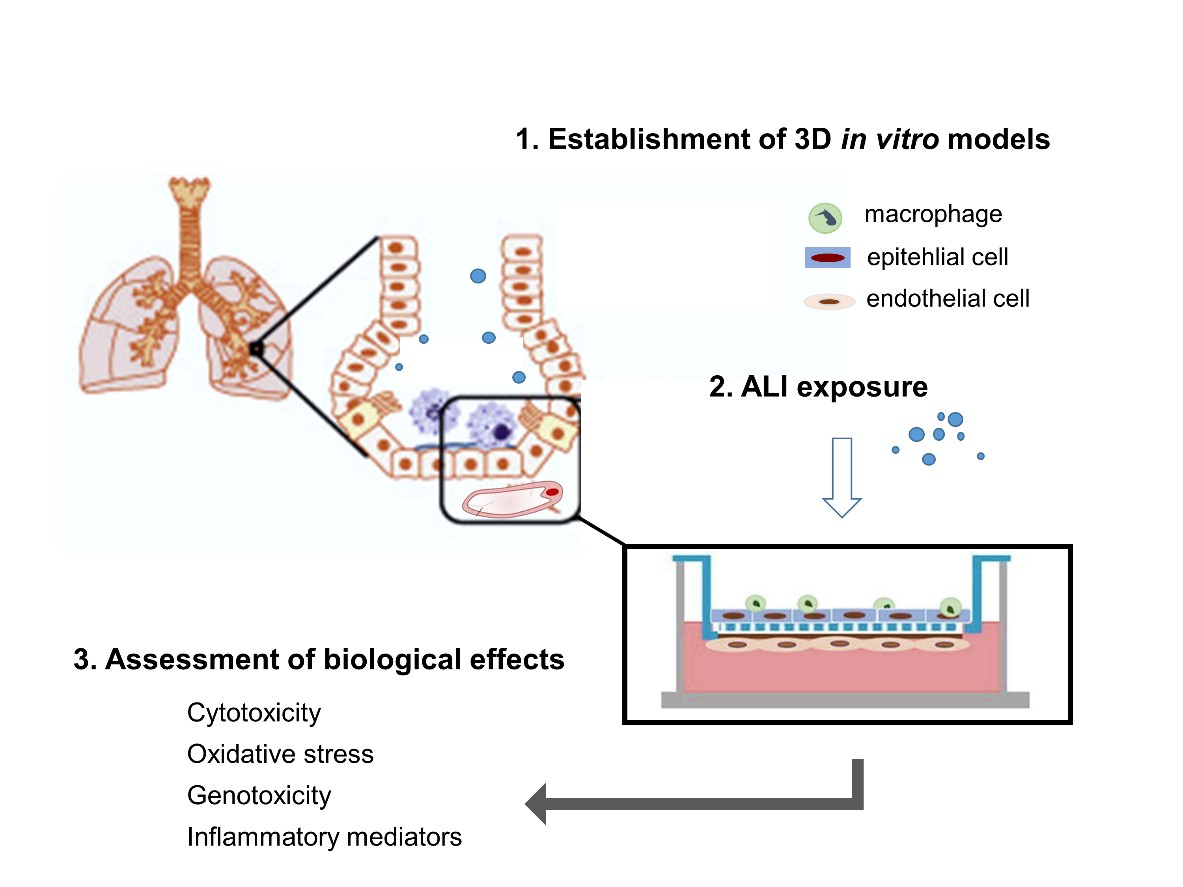Increased use of nanotechnology in consumer products raises concerns as to its potential impact on human health. Nanotechnology utilizes the unique properties of nanoparticles, arising from their nanoscale dimensions, which enables the development of new materials and devices within a vast range of applications, such as in nanomedicine, nanoelectronics, bioengineering, energy production and various consumer products (e.g. cosmetics, paint, food, and packing materials).
Consumers may be exposed to nanomaterials, but high exposure levels occur mainly in occupational settings in the production, use and handling of the materials. In work environment, inhalation is the major route of exposure. Data indicate that pulmonary exposure to nanomaterials may lead to development of acute and chronic inflammation, fibrosis, lung and mesothelial tumors.1,2,3 With increased use of nanomaterials, a need for improved cellular models has arisen in order to minimize the use of animal studies in risk assessment of nanomaterials. In this project, we will focus on establishing and using advanced 3D pulmonary models, and investigate molecular mechanisms of inflammatory, fibrotic and genotoxic responses of pulmonary exposure to titanium dioxide (TiO2) and nickel (Ni) nanoparticles.

Master projects:
I. Mechanisms of nanoparticle-induced oxidative stress and genotoxicity
Pulmonary effects of Ni nanoparticle exposure will be investigated using a cellular co-culture model consisting of lung epithelial cells, endothelial cells and macrophages. The co-culture will be air lifted and exposed to nanoparticles at air-liquid interface (ALI) to mimic pulmonary exposure scenarios.4 Effects on cell stress and genotoxicity will be investigated.
The following techniques will be used:
- Cell culture: Use of an advanced co-culture cell model
- Air-liquid interface (ALI) exposure of cells to nanomaterials
- Nanomaterial handling and characterization by Dynamic light scattering (DLS)
- Analysis of cell viability (such as Alamar Blue and LDH assay)
- Analysis of reactive oxygen species (ROS) by DCFH-DA assay or flow cytometry
- Analysis of apoptosis by flow cytometry
- Assessment of genotoxicity by comet assay
II. Assessment of biological responses in advanced 3D tissue models following exposure to nanoparticles.
A biologically relevant model of the human lung will be used to investigate immunological and cytotoxical responses to TiO2 and/or Ni nanoparticles. For this purpose the commercial EpiAirway™ 3D tissue constructs, which are human-derived cell cultures of differentiated airway epithelial cells, will be used. The constructs with/without macrophages will be exposed to nanoparticles at air-liquid interface (ALI) to mimic pulmonary exposure scenarios.
The following techniques will be used:
- Cell culture: Use of 3D tissue model and co-culture with/without macrophages
- Air-liquid interface (ALI) exposure of cells to nanomaterials
- Nanomaterial handling and characterization by Dynamic light scattering (DLS)
- Analysis of cell viability (such as Alamar Blue and LDH assay)
- Isolation of RNA and analysis of gene expression with qPCR
- Cytokine measurements with Luminex technology
- Transepithelial electrical resistance (TEER) measurement
Supervisors:
The master project will take place at the National Institute of Occupational Health (STAMI) in the group of Occupational Toxicology. STAMI is a world leading multidisciplinary environment for research on occupational health. Our research activities in nanotoxicology is in collaboration with several national and international research institutes and the student will have the opportunity to attend frequent scientific presentations. The master student will join our research group consisting of several PostDocs, PhD students, and technicians, ensuring all the help and support needed to perform the suggested experiments. Researcher Johanna Samulin-Erdem will act as the main supervisor at STAMI.
References
1. Kasai T et al. Part Fibre Toxicol. 2016; 13(1):53.
2. Sargent LM et al. Part Fibre Toxicol. 2014; 11:3.
3. Mercer RR et al. Part Fibre Toxicol. 2013;10:33.
4. Klein SG et al. Part Fibre Toxicol. 2013; 10:31.